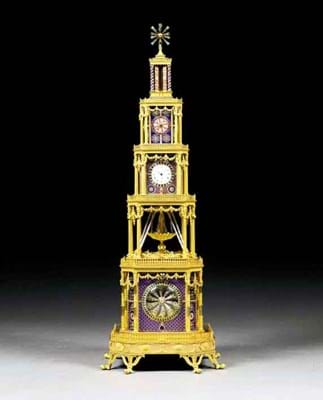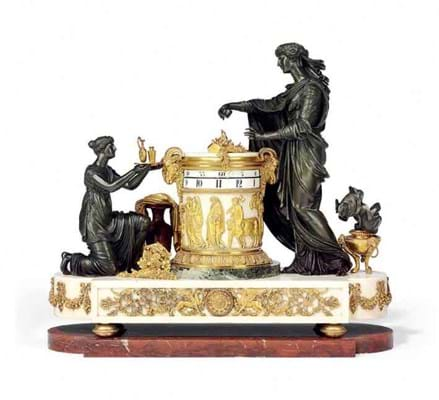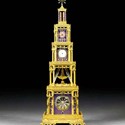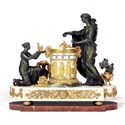In commercial terms these enamelled and paste-decorated showpieces can now rank alongside (or above) the likes of the Tompion and Breguet.
A classic top-flight example was included in Sotheby's (25/20/12% buyer's premium) Treasures sale on July 9, the pared-down, end-of-season auction devoted to high-value, provenanced furnishings and objects offered at the same time as their Old Master sales.
It stood an impressive 3ft 9in (1.16m) high, was composed of five tiers and made from ormolu with multi-coloured Swiss enamelling and paste gems. The works included various automata: a revolving star finial and revolving whorls, a revolving glass rod 'waterfall' with swans on a pond and an accompanying musical movement playing eight airs via a pinned cylinder and hammers.
It was signed Thompson London, dated from c.1790 and had a notable provenance. Originally one of a pair that had been in the Imperial Palace in Jehol, it was acquired, probably between 1913 and 1924, by Gustave Loup who came from a family of Swiss watch and clock dealers but was born in Tienstsin in 1876 where he established a watch import business before leaving for Switzerland in 1930. The clock was sold by Loup to Jacques-David LeCoultre, of the eponymous watch company, whose son sold it to the father of Sotheby's vendor in 1953.
Asian Demand
Eleven years ago Christie's sold the companion piece to this clock for a substantial £500,000. It is an illustration of the explosion in value of these Chinese market timekeepers in the interim that this example was offered earlier this month with an even higher £1m-1.5m estimate, a guide which it duly surpassed on the night when an Asian buyer seated in the room bid no less than £1.95m to secure it against a phone underbidder.
Sotheby's sale also featured a much earlier automaton clock from the European Renaissance arena. A 14½in (37cm) high, gilt-brass unicorn made in Southern Germany c.1590 was fitted with a three-train striking movement to animate articulated eyes and a lower jaw. Now with a replaced chapter ring and two hands, Sotheby's had estimated it at £100,000-150,000 only to see it taken to £600,000 on the day.
Mantel Clock
Meanwhile, the best-selling clock at Christie's (25/20/12% buyer's premium) Exceptional sale on the evening of July 10 was this Louis XVI period figural mantel clock, a classical design attributed to Jean-Guillaume Moitte with a case attributed to Pierre-Philippe Thomire, containing the movement in the central cylindrical pillar with revolving chapter rings at the top. It had a provenance back to c.1805, to Timothy Hutton or his heir John Pulleine, for Clifton Castle, Ripon and by descent, and sold for a mid-estimate £140,000.
Much more had been hoped for from the other horological entries but two Breguet clocks and a month-going regulator made by John Arnold for the Royal Observatory failed to sell.









